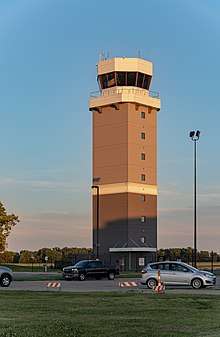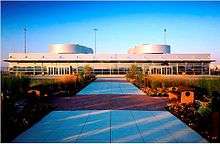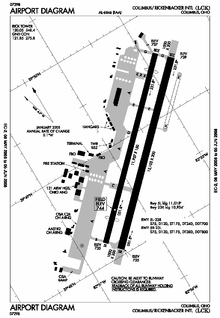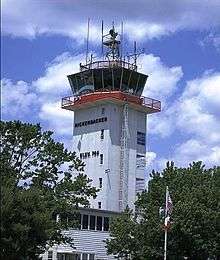Rickenbacker International Airport
Rickenbacker International Airport (IATA: LCK, ICAO: KLCK, FAA LID: LCK) is a civil-military public airport 10 miles (16 km) south of downtown Columbus, near Lockbourne in southern Franklin County, Ohio, United States. The south end of the airport extends into Pickaway County. The base was named for flying ace and Columbus native Eddie Rickenbacker. It is managed by the Columbus Regional Airport Authority, which also operates John Glenn Columbus International Airport and Bolton Field.[1] Rickenbacker International is primarily a cargo airport for the city of Columbus, although since 2012 it has served an increasing number of passenger flights as well as charter carriers.[2]
Rickenbacker International Airport | |||||||||||||||
|---|---|---|---|---|---|---|---|---|---|---|---|---|---|---|---|
 | |||||||||||||||
 | |||||||||||||||
| Summary | |||||||||||||||
| Airport type | Public | ||||||||||||||
| Operator | Columbus Regional Airport Authority | ||||||||||||||
| Serves | Columbus, OH | ||||||||||||||
| Location | Franklin / Pickaway counties, near Columbus, Ohio | ||||||||||||||
| Hub for | |||||||||||||||
| Elevation AMSL | 744 ft / 227 m | ||||||||||||||
| Coordinates | 39°48′50″N 082°55′40″W | ||||||||||||||
| Public transit access | |||||||||||||||
| Website | rickenbackeradvantage | ||||||||||||||
| Map | |||||||||||||||
 LCK Location of airport in Ohio / United States  LCK LCK (the United States) | |||||||||||||||
| Runways | |||||||||||||||
| |||||||||||||||
| Statistics (2017) | |||||||||||||||
| |||||||||||||||
The United States Air Force maintains a presence in the form of the Ohio Air National Guard's 121st Air Refueling Wing, Rickenbacker International is also home of the Ohio Army National Guard's Army Aviation Support Facility No. 2 and the headquarters for the Ohio Military Reserve, one of the state defense forces of Ohio.
History
The facility opened in June 1942 as Lockbourne Army Airfield (named after the nearby village of Lockbourne). It was then named the Northeastern Training Center of the Army Air Corps, and provided basic pilot training and military support. In addition, the training center provided B-17 flight training to the Women Airforce Service Pilots (WASPs), and training for glider pilots in the CG-4A Waco glider. After the war, flight-training activities were halted and the airfield was used as a development and testing facility for all-weather military flight operations. The primary unit at the base was the all-Black 447th Composite Group, also known as the Tuskegee Airmen.
During the Cold War the facility was Lockbourne Air Force Base and was assigned to the USAF Strategic Air Command. Lockbourne AFB was redesignated Rickenbacker Air Force Base on May 18, 1974, by Department of the Air Force Special Order GA-11 of March 6, 1974, to honor Columbus native Eddie Rickenbacker, the leading American fighter pilot of World War I.
The base was transferred from the Strategic Air Command (SAC) to the Air National Guard and redesignated Rickenbacker Air National Guard Base on April 1, 1980.

The base was recommended for closure by the 1991 Base Realignment and Closure Commission, but as a result of a proposal by the State of Ohio, the 1993 Commission recommended that Rickenbacker ANGB be realigned rather than closed. The Commission decided to retain the 121st Air Refueling Wing and the 160th Air Refueling Group of the Ohio Air National Guard in a military cantonment area at Rickenbacker ANGB instead of realigning to Wright-Patterson AFB. The Air National Guard would continue to operate as tenants of the Rickenbacker Port Authority (RPA) on the RPA's airport and the military facilities were realigned as Rickenbacker Air National Guard Station on September 30, 1994 by the 1991 Congressional Base Realignment and Closure Commission.
In August 2001 construction started on a new, consolidated Navy and Marine Corps Air Reserve Center at Rickenbacker International Airport. The $10 million center, scheduled for completion in early 2003, will be located at the intersection of 2nd Avenue and Club Street adjacent to the Air National Guard facility at Rickenbacker. Being developed by the Navy Reserve, the project will consolidate the Naval Air Reserve Center at Rickenbacker with the Navy and Marine Corps Reserve Center currently located on Yearling Road in Columbus. When completed, the nearly 1,000 Navy and Marine Corps reservists currently located at the two existing reserve centers will shift their activities to this new facility. Once the new center opens, the site of the existing Naval Air Reserve Center at Rickenbacker will be redeveloped by the Columbus Regional Airport Authority, which operates the 5,000-acre (2,023 ha) airport.
Operations
Rickenbacker was run by the Rickenbacker Port Authority, until merging in 2003 with Port Columbus and Bolton field creating the Columbus Regional Airport Authority. As of July 2006, Rickenbacker is the world's 126th busiest cargo airport according to Air Cargo World.[3] Rickenbacker ranks as one of the worlds top 20 fastest growing cargo airports in July 2006 with 112,888 tons, a 15.3% increase from the previous year. This is mainly due to the transfer of AirNet Systems operations from Port Columbus International Airport to Rickenbacker. This number is expected to increase with the introduction of the new intermodal facility that is under construction. As of now it has scheduled service from FedEx Express along with FedEx Feeder contractors, Mountain Air Cargo and CSA Air and UPS Airlines along with contractors Air Cargo Carriers. Multi-weekly 747 freighter service is operated by Atlas Air and Kalitta Air. Another airline based at Rickenbacker is Snow Aviation.
Rickenbacker International Airport was also the site for filming all aircraft exterior shots in the movie Air Force One starring Harrison Ford while also acting as Ramstein Air Base in the film. In 2007, Rickenbacker hosted the Gathering of Mustangs and Legends air show, one of the largest-ever gatherings of operable classic warbirds, especially the P-51 Mustang.
Facilities and aircraft


Rickenbacker International Airport covers 4,342 acres (1,757 ha) and has two runways:[1]
- Runway 5R/23L: 12,102 ft × 200 ft (3,689 m × 61 m) Asphalt/Concrete
- Runway 5L/23R: 11,902 ft × 150 ft (3,628 m × 46 m) Asphalt
In the year ending December 31, 2017 the airport had 26,661 aircraft operations, average 73 per day: 54% air carrier, 29% military and 17% general aviation. 28 aircraft at the time were based at the airport: 3 single engine, 3 multi-engine, 3 jet aircraft, and 19 military aircraft.[1]
In December 2006 PlanetSpace entered negotiations with the Ohio government to build a spaceport at Rickenbacker.[4]
Also in 2006, the Columbus Regional Airport Authority completed a Noise Compatibility Study for the airport. This program helps to guide suggested flight paths and targets soundproofing of buildings exposed to high levels of aircraft noise.[5]
AirNet Express headquarters is on the airport.[6]
In 2008, Norfolk Southern opened the Rickenbacker Intermodal Terminal adjacent to the airport.[7] This facility allows the handling of approximately 250,000 Intermodal containers annually and anchors Norfolk Southern's Heartland Corridor. The project allows easy access to and from the deep water port at Norfolk, Virginia via the use of double stack containers as well as improved access to rail hubs in the Chicago area.

Airlines and destinations
Since the completion of the current passenger terminal in 2003, Rickenbacker has acted as a secondary airport for Columbus and the airport has seen a number of carriers come and go,[8] including Southeast Airlines, Boston-Maine Airways, Hooters Air, Direct Air, USA3000 Airlines, Fly Mission Air and Vision Airlines.[9][10] In 2012, low-cost carrier Allegiant Air launched service to Sanford and St. Petersburg, FL and has since been successful in expanding service to ten additional leisure destinations in the southern United States.
Passenger
| Airlines | Destinations | Refs |
|---|---|---|
| Allegiant Air | Fort Lauderdale, Orlando/Sanford, Punta Gorda (FL), Sarasota, St. Petersburg/Clearwater Seasonal: Charleston (SC),[11] Destin/Fort Walton Beach, Jacksonville, Myrtle Beach, Norfolk,[12] Savannah | [13] |
Destinations map
| Passenger destinations map |
|---|
 Columbus-Rickenbacker Fort Lauderdale Passenger destinations from Rickenbacker International Airport Year-round destination Seasonal destination Future destination |
Cargo
| Airlines | Destinations |
|---|---|
| AirBridgeCargo | Moscow–Sheremetyevo,[14] Liège[14] |
| Asiana Cargo | Los Angeles,[15] Seoul–Incheon |
| Cargolux | Anchorage,[16] Chicago–O'Hare,[17] Luxembourg,[17] New York–JFK[16] |
| Castle Aviation | Akron/Canton,[18] Cleveland[19] |
| Cathay Pacific Cargo | Anchorage,[20] Atlanta,[20] Chicago–O'Hare,[20] Hong Kong |
| China Airlines Cargo[21] | Anchorage, Chicago–O'Hare, Taipei–Taoyuan, Seattle/Tacoma |
| Emirates SkyCargo | Chicago–O'Hare,[22] Dubai–Al Maktoum, Frankfurt,[23] New York–JFK[23] |
| Etihad Cargo | Abu Dhabi, Amsterdam, Anchorage, Colombo–Bandaranaike, East Midlands,[24] Hanoi, Miami |
| FedEx Express | Baltimore,[25] Cleveland,[26] Detroit,[27] Indianapolis,[28] Memphis,[29] Newark,[30] Richmond[28] Seasonal: Hartford[31] |
| FedEx Feeder | Indianapolis,[32] Parkersburg[33] |
| UPS Airlines | Chicago–O'Hare, Louisville, Miami, Pittsburgh[34] Seasonal: Hartford[35] |
Motor racing
In 1953 and 1954 the airport was used for two meetings organised by the Sports Car Club of America.[36]
See also
- Central Air Defense Force (Air Defense Command)
- 121st Air Refueling Wing
References
![]()
- FAA Airport Master Record for LCK (Form 5010 PDF), effective July 5, 2007
- "Archived copy" (PDF). Archived from the original (PDF) on August 21, 2016. Retrieved August 5, 2016.CS1 maint: archived copy as title (link)
- Air Cargo World: "Top Cargo Airports of the World" with focus on Africa and Asia. Archived April 11, 2009, at the Wayback Machine Retrieved July 8, 2007.
- "Spaceport Ohio?". Personal Spaceflight. December 2, 2006.
- "Rickenbacker International Airport – Noise Program – Columbus Regional Airport Authority".
- "Contact Archived October 29, 2010, at the Wayback Machine." AirNet Express. Retrieved on February 12, 2011. "Corporate Office: AirNet Systems, Inc. 7250 Star Check Drive Columbus, OH 43217."
- "Data" (PDF). www.nscorp.com.
- "Aggregated data". docs.newsbank.com.webproxy3.columbuslibrary.org.
- Heath, Dan (April 12, 2012). "Direct Air bankruptcy goes to Chapter 7". Plattsburgh Press-Republican. Retrieved April 16, 2012.
- "Aggregated data". docs.newsbank.com.webproxy3.columbuslibrary.org.
- https://www.dispatch.com/business/20190212/allegiant-adds-charleston-south-carolina-flights-from-rickenbacker
- "Allegiant Announces Largest Service Expansion In Company History With 3 New Cities And 44 Nonstop Routes". Allegiant Airlines.
- "Allegiant Air". Retrieved January 7, 2017.
- "AirBridgeCargo adds Columbus Rickenbacker from April 2018". Routesonline. Retrieved June 14, 2018.
- https://columbusairports.com/storage/production/20190823125957-craa-board-of-directors-meeting-pre-read-august-27-2019.pdf
- "CLX452". Retrieved January 13, 2018.
- "CLX436". Retrieved January 13, 2018.
- "Castle Aviation 821". Retrieved January 13, 2018.
- "CSJ821". Retrieved January 13, 2018.
- "CPA92". Retrieved January 13, 2018.
- https://columbusairports.com/storage/production/20180622150347-06-2018-board-pre-read.pdf
- "UAE9961". Retrieved January 13, 2018.
- "Emirates 9251". Retrieved January 13, 2018.
- https://www.etihad.com/en-us/about-us/etihad-news/archive/2018/etihad-cargo-and-trinity-logistics-renew-partnership-extending-rickenbecker-services/
- "FDX1730". Retrieved January 13, 2018.
- "FDX437". Retrieved January 13, 2018.
- "FedEx 846 FDX846 / FX846". Retrieved January 13, 2018.
- "FDX1639". Retrieved January 13, 2018.
- "FedEx 1237". Retrieved January 13, 2018.
- "FedEx 1938". Retrieved January 13, 2018.
- https://flightaware.com/live/airport/KBDL BDL-LCK FedEx
- "Mountain Air Cargo 8327". Retrieved January 13, 2018.
- "Mountain Air Cargo 8474". Retrieved February 4, 2018.
- "UPS1151". Retrieved January 13, 2018.
- https://flightaware.com/live/airport/KBDL BDL-LCK UPS
- Strohl, Daniel. "One of the last of the AFB races: Lockbourne, 1953". www.hemmings.com. Retrieved September 6, 2019.
External links
- Official website
- FAA Airport Diagram (PDF), effective June 18, 2020
- Resources for this airport:
- FAA airport information for LCK
- AirNav airport information for KLCK
- ASN accident history for LCK
- FlightAware airport information and live flight tracker
- NOAA/NWS weather observations: current, past three days
- SkyVector aeronautical chart, Terminal Procedures
- Historical Photos